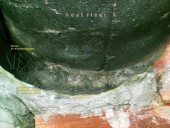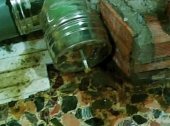


Glenn Herbert wrote:Unless you have a constant wind direction for the whole heating season, "lee/downwind" is not so important for you, as you really need to make your chimney to work well in any kind of wind. This means running it up to at least a meter above the peak of your roof, even if the peak is 3 or 4 meters away from the chimney.
It will be easier to support this chimney if it goes up inside the house and exits near the peak. This will also keep the chimney warmer and improve your draft, and lose less heat to outdoors.
There is no drawback to having a chimney inside a house except the space it takes. An internal chimney will pull no more heat out of the house than an insulated external chimney, and it will draw better in nearly all conditions.
Glenn Herbert wrote:If you have any issue with losing room air while not burning, you can do what is a common practice and cover the feed tube with two bricks when the fire is out.

allen lumley wrote:You on the other hand are trying to retro-fit a Rocket Mass Heater RMH into an existing structure.
allen lumley wrote:Notice the Amount of wood being burned. Here two bricks have been used to partially close off the Feed tube opening. This helps our fire in more than one way.
1) By Flowing Downward past the sticks of fuel wood it cools the sticks preventing smoke back!
2) as it flows through the fire the Air warms up and keeps the Firebrick that lines the Burn Tunnel and the Heat Riser Hot. Thus the proper Wood Fuel To Air Ratio keep excess air from cooling you combustion zone !
While we start with tinder and then kindling , we can fill the Feed Tube opening with small very dry wood and within 15 minutes have the walls of the Burn Tunnel glowing Red
allen lumley wrote:Your best Tool to operate your Rocket correctly is your ears. When your rocket is running correctly you will be able to hear its roar !
allen lumley wrote:So- tell me again exactly what happens to your horizontal chimney from its ending through how many elbows or tees
allen lumley wrote:
See link Below :
http://s65.photobucket.com/user/mremine/media/NYC%20Rocket%20Stove%20Build/P1030331.jpg.html?sort=3&o=6

allen lumley wrote:proteas vryssas : Please answer clearly, what kind of floor do you have under your RMH,
allen lumley wrote:have you covered your piping now?
allen lumley wrote:And was the piping covered before when you discovered the water problem ?
allen lumley wrote:Your Final vertical chimney should be an internal chimney exiting near the peak of your roof!
allen lumley wrote:With an outside chimney it needs to be located on the Lee or Downwind side of your house and be at least 1 meter higher that the peak of your roof, or other nearby object !
 Then one professional fireplace builder come and said that it needs to be raised again and when that didn't work either then another professional fireplace builder come and place a expensive and aloud motor on top of that chimney. After a while the motor stack because of ash, creosote and harsh conditions. But the motor "solution" had some other side effects! When worked to drag the smoke from the room, it is also remove all the heat produced by the fireplace and make the room loud too. So I don't ever need to know what the Lee or Downwind or the common chimney builders technique said (no offense).
Then one professional fireplace builder come and said that it needs to be raised again and when that didn't work either then another professional fireplace builder come and place a expensive and aloud motor on top of that chimney. After a while the motor stack because of ash, creosote and harsh conditions. But the motor "solution" had some other side effects! When worked to drag the smoke from the room, it is also remove all the heat produced by the fireplace and make the room loud too. So I don't ever need to know what the Lee or Downwind or the common chimney builders technique said (no offense).

F Styles wrote:Do you have a water tank set up in this pic? if so where did you place it in your system? can you please post more pics.


allen lumley wrote: It has been reported here that with a gap between the top of the Heat Riser and the underside of the barrel greater than 3'' this temperature difference reverses itself !
allen lumley wrote:Being very stingy with my money is my best reason for going with cob instead of concrete; However in your case the concrete does not seem to be absorbing the water released from /and produced by the wood you are burning. Always burn the driest wood you can ! Cob is generally highly regarded for its ability to hold onto lots of Water when the moisture levels are high, and venting it when the Moisture levels are low !
allen lumley wrote:Running a small fan to increase the movement of air through your RMH will help dry things out but you need to vigilantly look for other outside sources for your water problem ! Again the fan should help stop smoking at the feed tube !
allen lumley wrote: How tall is your final Vertical Chimney?



allen lumley wrote: While I totally do not understand the leaks and tracks at the top of the barrel ( how did you seal this location? )
allen lumley wrote: I am sure that most of your problem is related to drying out your Cob ! Even 3 weeks is not too long top dry out your Cob depending on the way you made it !
allen lumley wrote:In a perfect world Your cob should act as an incredible sponge when the outside air is high humidity absorbing water vapor into its core
allen lumley wrote:and when then Outside vapor is low physically pumping Water Vapor into the Atmosphere, and increasing the latent heat of evaporation - This works out to be More Free Heat on the coldest days !
allen lumley wrote: For theGood of the Crafts ! Big AL


F Styles wrote:Make sure if you have an elbow or a TEE at the up point make sure it tilts a bit down away from the house and put a drain vent/hole at the lowest part of the tilt to drain the condensation.
F Styles wrote:I would like to ask are your exhaust ducts pointing down, up, or level as they go out to the up stack?
F Styles wrote:a level stack with low center point will be the worst scenario.
F Styles wrote:make sure inside ducts have mass around them.
F Styles wrote:do not cool the mass or pipe down too much with a water tank
F Styles wrote: make sure you put a little piece of insulation in the clean out duct lid and the condensation should stop there for the most part.